Welcome to Valhalla: Inside the New 250GB Xbox 360 Slim
by Anand Lal Shimpi on June 18, 2010 1:59 AM ESTI own a total of five Xbox 360s. Four of them have died. Three because of the Red Ring of Death, all out of warranty. Many have had serial Xbox 360 failures, I had them in parallel.
The last revision of the Xbox 360, codenamed Jasper, was supposed to fix the infamous RRoD problem. So far my Jasper has been running fine. While Microsoft never confirmed the cause the RRoD seemed to be a result of poor cooling and manufacturing issues (either at the die/underfill level or at the solder level or both).
Needless to say, I wasn’t terribly happy about purchasing a sixth Xbox 360, but here it is:
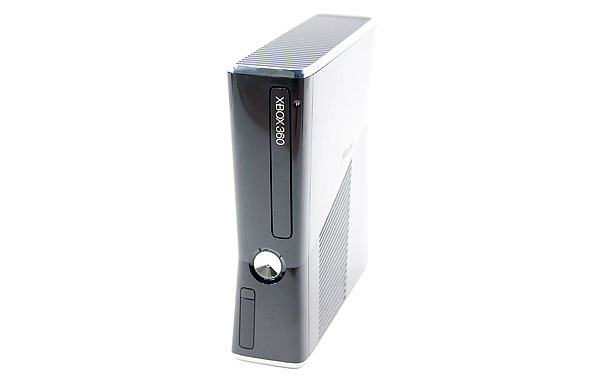
This is the latest revision of the Xbox 360, commonly referred to as the Xbox 360 Slim thanks to its shrinking in virtually all dimensions compared to the previous white box:
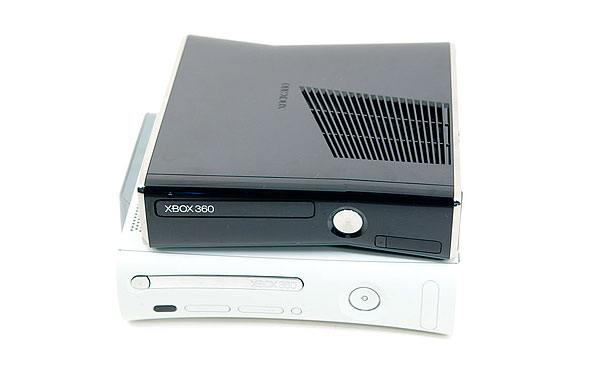

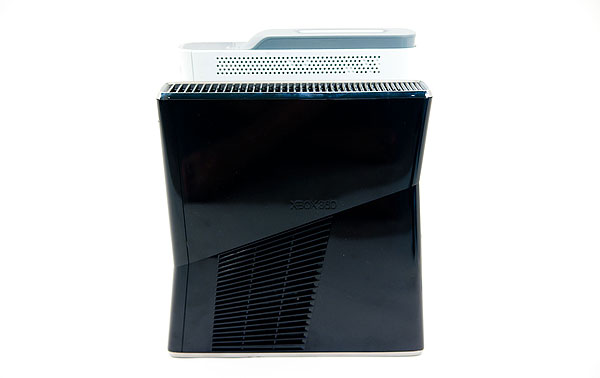
The internals are mostly new, featuring for the first time a single chip with CPU, GPU and eDRAM. Prior to this motherboard revision the Xbox 360 motherboard had two discrete packages, one with the CPU and one with the GPU + eDRAM.
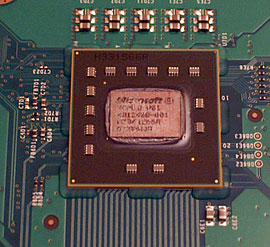 |
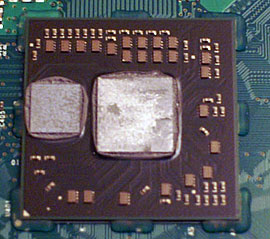 |
For those of you who don't remember, ATI originally designed the Xbox 360's GPU and called it Xenos. The GPU was the first we ever looked at that used a unified shading architecture, so there were no dedicated pixel or vertex units. The core was made up of 48 shader processors and each SP could work on a vect4 plus a scalar op in parallel. These days we'd probably call it a GPU with 240 cores, although it's a bit dated from a functionality standpoint. The GPU runs at 500MHz and is also home to the memory controller.

On a separate die, which ATI referred to as the daughter die, was 10MB of embedded DRAM along with all of the hardware necessary for z and stencil operations, color and alpha processing and AA. This eDRAM and associated logic helped Microsoft bring AA to games and improve overall performance compared to what was possible at the time with conventional architectures.
The CPU, codenamed Xenon, implemented three in-order PowerPC cores with SMT support - meaning the whole chip could work on six threads at the same time. The design was ahead of its time but given its 90nm manufacturing process it only had 1MB of L2 cache to share among all three cores. These days it isn't really considered the ideal approach to a many-core CPU. Private L2 caches with a large shared L3 cache is preferred for scaling beyond two cores.
Leading up to Jasper, each die was shrunk independently with each Xbox iteration. The table below shows us how:
| Xbox 360 Revision | CPU | GPU | eDRAM |
| Xenon/Zephyr | 90nm | 90nm | 90nm |
| Falcon/Opus | 65nm | 80nm | 80nm |
| Jasper | 65nm | 65nm | 80nm |
With the new Xbox 360 (codenamed Valhalla), at least two, possibly all three of the die are combined and placed on a single package:

Bringing it all onto (presumably) a single die makes cooling much simpler as now there’s only one heatsink and one fan for all of the major heat generating components in the unit. This level of integration is made possible only by the not-so-magic of Moore’s Law. At 40nm it shouldn’t be a problem to bring all of those components onto a single reasonably sized die, which in turn reduces Microsoft’s manufacturing costs. It’s not totally clear whether Microsoft is building these chips on a 40nm, 45nm or 55nm node. The 40nm approach would make the most sense but TSMC is very capacity constrained at this point so it would be a slow ramp before all Xboxes got the Valhalla treatment. Update: Apparently 45nm is the magic number. The new CGPU is rumored to be made at Chartered Semiconductor, now under the ownership of Global Foundries.
The uncertainty is because of a pesky heat spreader. While previous Xbox 360 CPU/GPUs were visible to the naked eye once you popped the heatsink off, the Valhalla design has a heat spreader covering the Xbox CGPU (Microsoft’s term, not mine). Unwilling to potentially kill yet another Xbox 360, I’ve left my heat spreader intact for the purposes of this article.
What follows is an entire dissection guide for those of you who want to get inside the new Xbox 360 (for whatever reason you might have ;), as well as some power/noise information for those of you contemplating the upgrade.
Enjoy.










109 Comments
View All Comments
bill4 - Friday, June 18, 2010 - link
Hugely disappointed you didnt tear the heatspreader off and measure the chips. That's my favorite part of these teardowns besides maybe the power draw numbers.Also disagree we'll see X360 power in a phone in three years. Heck you dont even see PSP power in a phone now, which is way less than a PS2. And PSP is like 6 years old!
Also, the reason high end PC market isn't tapped anymore is piracy. That's obvious. The same piracy your affiliate over at Dailytech Jason Mick supports so strongly.
bill4 - Friday, June 18, 2010 - link
Oh and forgot, the asthetics is a matter of opinion. I tend to think that while the lure of the shiny and new is overpowering here, objectively if I were honest the old X360 matte Elite looks better imo. The old X360 Elite is the best looking console ever imo.Also, it's pretty funny how 360 and PS3 have switched positions in regard to capacitive buttons and glossy finishes.
Personally I dont like capacitive buttons, I have them on my samsung blu ray player and dont care for it. I prefer the tactile feedback of knowing yes, I pushed the button. I find myself wanting to jam on capacitive buttons all the time to make sure I pressed it, or maybe because I'm used to regular buttons.
It's good to see MS is thinking about end user experience in a bit of an Apple way here and including some rubber bits to dampen sound though.
Also, I disagree that MS is waiting on 40nm volumes to pick up to drop prices. As I posted in the other article, I think Kinect has totally screwed up their pricing. For now they are just in a pricing hold while they figure out what theyre going to do with kinect regarding bundling and the like, and Kinect may in fact be bundled with a price raise raise, or a steady price, thereby negating the cut that would have occurred had kinect not existed. Because I still think an argument can be made Kinect and Move will have to be bundled with every new SKU sold to avoid an uncertain fate that has befallen past optional add ons.
tim851 - Friday, June 18, 2010 - link
The high end PC market is still tapped sufficiently. The (in my view) most important titles are all released there, that is why I don't bother getting a console. And that is despite MS and Sony trying their a$$ off to convince developers to go system exclusive.bill4 - Friday, June 18, 2010 - link
What important titles are released only on PC? Besides the upcoming Starcraft 2 maybe, one really major title in three years.It's all just console ports now. Even Crytek (Id, Epic, Valve) has now gone that way. How is this even arguable?
Guspaz - Friday, June 18, 2010 - link
I think the OP meant the opposite of what you understood. He's saying that he doesn't need a console because most games are *also* released on the PC, not *only* released.coburn_c - Friday, June 18, 2010 - link
"Heck you dont even see PSP power in a phone now..."I... don't think you know what you're talking about.
bill4 - Friday, June 18, 2010 - link
What phone games look better than top PSP games? I'll be waiting...Guspaz - Friday, June 18, 2010 - link
The PowerVR SGX535, as used in most current smartphones (with the snapdragon being an exception), is roughly equivalent to the graphical power of the PSP. Without knowing more about the architectures, the 535 has does 28MPolys/sec, while the PSP's does 33. The 545, which doesn't appear to be in any shipping devices yet, should be slightly faster than the PSP's.Of more note is that the PSP has a very limited amount of VRAM available. In general, a smartphone can expect to have 16 to 32 times more usable RAM than the PSP, and likely at significantly faster speeds (the PSP's is DDR, while smartphones these days are using DDR2)
In terms of processing power, any modern smartphone should take the PSP to task, as the PSP's 333Mhz MIPS R400 is pretty dated. These days, smartphones are shipping with ARM Cortex A8 chips at up to 1GHz, usually on a much smaller manufacturing process (the PSP is still at 90nm). Dual-core Cortex A9 chips at 1GHz or higher should make it to market before the PSP's successor is released. It was rumoured that the Nintendo 3DS would use an nVidia Tegra 2 featuring an A9, but these rumours haven't been confirmed.
So, on a hardware level, the PSP is outclassed by modern smartphones in every category except the GPU (where it may have a small advantage). Ultimately, however, it has an enormous advantage in one specific place that makes everything else moot; OS overhead. While smartphones are much faster on paper, they're constrained by large amounts of OS overhead that bring down their real-world performance significantly. There's still going to be more RAM and CPU power available after overhead, but the demands of the underlying OS can introduce enough latency to cause issues.
Ultimately, we're seeing a lot of convergence. The hardware in smartphones and handheld consoles is pretty analogous, and in the case of Nintendo's products, probably the same. Even if the 3DS doesn't use the nVidia Tegra, we know it's still using some sort of ARM processor, and that's going to be either a Cortex A8 or A9, just like smartphones are using. From Sony's perspective, the PSP2 is rumoured to use some sort of multi-GPU PowerVR SGX product.
I should probably bring this back to the original topic and say, modern smartphones do have the power of a PSP (and then some), so you should really re-examine the hardware going into modern devices. Of course, as I said, OS overhead hurts, but even that won't matter much if the PSP doesn't get a successor soon.
At the risk of rambling on a bit, the iPod Touch 3rd gen was a pretty direct competitor to the PSP Go. They had similar size and resolution screens, similar capabilities in terms of graphical quality, they're both gaming handhelds (even Apple doesn't claim that the iTouch products are music devices anymore, they now consider them gaming devices), they both get their content via DLC, and they have similar costs (the iTouch 8G costing $199, the PSP Go costing $250).
mczak - Friday, June 18, 2010 - link
smartphones today are actually still using lpddr (on a 32bit bus, I believe) at fairly low clocks, I don't think the typical Cortex A8 they use supports lpddr2 (maybe the A4 used in the iphone 4 being an exception?) but next gen should be lpddr2. I'm not sure at all about the memory interface of the psp, but in any case this also had (fairly small) embedded dram which likely offers more bandwidth than todays smartphones. That said, the tile based deferred renderer sgx family used on smartphones shouldn't really need that much bandwidth.Macha - Saturday, June 26, 2010 - link
Actually, price wise, you need to compare the 32Gb model to the PSP. The 8GB model doesn't have the increased power of the other third generation models.